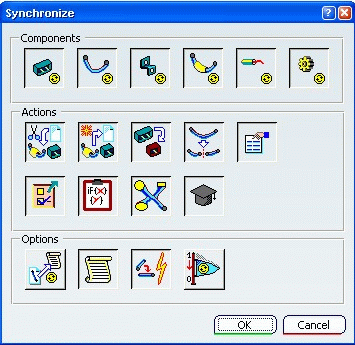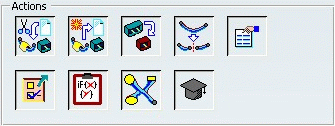About Synchronization | |||||||
|
| ||||||
The Synchronize Process
You can automatically synchronize your 3D flattened geometry at any time during your session. You can add missing components or remove additional components, as well as synchronize the segment structure.
The Synchronize command takes interconnected components into account. It does not manage isolated components that are not connected to the network. For example, flattened geometry that contains an isolated component that is subsequently connected in the 3D geometry will always exist as a free-hanging component after synchronization and the flattened geometry will show a new component connected to the network.
Retainers and split branches are taken into account in the Synchronize process.
Synchronize Options
The Synchronize dialog box provides a number of options you need to select. During the synchronization step, the selected options only will be performed. This optimizes the amount of time taken to synchronize.
A HTML report will be generated accordingly and will only show the selected options. For more information about the HTML report, see About the HTML Report.

This dialog box lets you define what you want to synchronize:
- Components
- Actions
- Options
Components

Components allows you to select which components you want to update:
- Devices

- Segments

- Supports

- Protective coverings

- Conductors

- Mechanical parts linked to the geometry
 .
You can add, remove and replace these parts.
.
You can add, remove and replace these parts.
Tip: To synchronize the dashed green line, select Mechanical Part under Components and Attributes under Actions. Moreover, you can use your own execution Business Rules to customize the Synchronization behavior on these components. For more information, please refer to: Using Business Rule Integration in the Extract and Synchronize commands.
You can select as many components as needed at the same time.
Actions

Actions allows you to customize the actions during the synchronization step:
 : Removes components from the flattened view that were deleted in the
3D geometry
: Removes components from the flattened view that were deleted in the
3D geometry : Adds components that were added to the 3D harness and are missing
in the flattened view
: Adds components that were added to the 3D harness and are missing
in the flattened view : Replaces the reference of components changed in the 3D geometry (this
option can only be used with the Supports or Devices
options activated.)
: Replaces the reference of components changed in the 3D geometry (this
option can only be used with the Supports or Devices
options activated.) : Updates the segment structure (this option can only be used with
the Segments option activated).
: Updates the segment structure (this option can only be used with
the Segments option activated).This option allows you to:
- Add a branch or a branch point,
- Add or remove intermediate segments
- Replace one or more segments with one or more different segments.
Important: If you transfer a branch to another electrical branch geometry, it will remain under the original electrical branch geometry in the flattened view when you synchronize.  : Updates attributes
This option allows you to:
: Updates attributes
This option allows you to:- Synchronize the position of protective coverings. To do so, select Protective coverings under Components.
- Synchronize the position of supports. To do so, select Segments and Supports under Components.
- Synchronize relationships (manually made using the Adjust command in Electrical 3D Installation) between the following components: (1) tape and segments or other protective coverings (2) adaptive supports and retainers, and segments or protective coverings. To do so, select Protective Coverings or Supports under Components as appropriate.
- Update the length of segments created along external curves.
-
 : Updates knowledge parameters.
This option allows you to synchronize the knowledge parameters added
to the protective coverings and segments. They
must be located under a parameter set named To be synchronized, under the protective covering or segment node.
: Updates knowledge parameters.
This option allows you to synchronize the knowledge parameters added
to the protective coverings and segments. They
must be located under a parameter set named To be synchronized, under the protective covering or segment node.This set needs to be created in the Knowledge Advisor workbench: To do so:
- Click Add a set of Parameters
 .
. - Change the name in the Properties dialog box to: To be synchronized.
- Place your parameters in this set by drag & drop.
Note:
- The synchronization does not manage the Remove of the knowledge para meters from flatten date whose corresponding parameter does not exist in the electrical geometry data.
- In the Specification Tree, only the protection knowledge parameters are visible whereas both protection and segment parameters can be found in the Parameters Explorer.
- Click Add a set of Parameters
Note:
- The changes to the segment shape are not updated on synchronization.
- On synchronizing a scaled branch or segment in the 3D flatten model, only the true length is synchronized, that is, the geometrical length is not changed. The position of the protective covering and support is updated to keep the same relative position.
Important:
|
Previously this action was performed when Attributes was selected.
- Update profiles
This option allows you to synchronize the multi-profile branch structure and associated attributes. To do so, select Segments under Components and Attributes under Actions.
You must also select Any Profile under Segment Profile (Tools > Options > Equipment > Electrical Discipline > Electrical Assembly Design >Electrical Geometry Management).

You can select as many actions as needed.
Options

Options lets you select the operations to run during synchronization:
 Simulate: generates a report without applying changes to the flattened
document
Simulate: generates a report without applying changes to the flattened
document HTML Report: generates the report in the
predefined folder specified in the Options dialog box
HTML Report: generates the report in the
predefined folder specified in the Options dialog box Flatten: Automatically flattens any added components
Flatten: Automatically flattens any added components Synchronize Flag: Resets the synchronization history of all components:
the synchronize property of all components is set to False,
so that only newly changed components will be set to True
after the synchronization operation.
Synchronize Flag: Resets the synchronization history of all components:
the synchronize property of all components is set to False,
so that only newly changed components will be set to True
after the synchronization operation.
Synchronizing the Backshell Orientation
During the synchronization process, the orientation angle between the Single Insert Connector (SIC) and the Backshell is synchronized with the 3D harness model.
The synchronization of the orientation angle is done only if Devices and Update Attributes are selected in the Synchronize dialog box. And only the SIC will be rotated to be synchronized at the new angle.
Synchronization of orientation can be done even if the orientation constraint is not defined while defining the Backshell connection point.
The connection point between the SIC and the Backshell is done through the Backshell Connection Point, and in general, a Mechanical Connection with three relations is automatically treated (it is called the Advanced Method):
- Contact
- Coincidence
- Orientation
In V6, the connection point between the two devices, SIC and Backshell:
- occurs by synchronizing the two relations of the Advanced Method: Contact and Coincidence. But it does not work with the Orientation relation.
- cannot be synchronized via the Axis system like in V5, with the three relations: Plane, Axis and Orientation.
Note that this method works with all the other devices and connections points in V6.
In the About the HTML Report, a column entitled Orientation from backshell is added under the List Devices Attributes Modifications category to show the orientation angle.
![]()
Methodology: Electrical Geometry Integration
It is recommended that you do not change the branch/segment orientation if you work in the context of Electrical Harness Flattening.
- If you first create the branch/segment this way:

- Do not modify it like this:

This would not be supported when synchronizing the data.